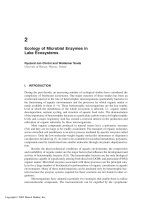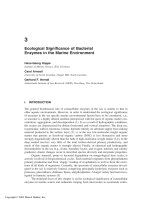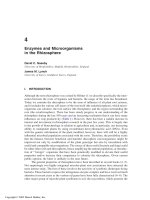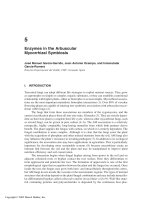the internal environment resources, capabilities and
Bạn đang xem bản rút gọn của tài liệu. Xem và tải ngay bản đầy đủ của tài liệu tại đây (284.81 KB, 51 trang )
Ch3-1
Chapter 3
Chapter 3
The Internal Environment:
The Internal Environment:
Resources, Capabilities and
Resources, Capabilities and
Core Competencies
Core Competencies
Michael A. Hitt
Michael A. Hitt
R. Duane Ireland
R. Duane Ireland
Robert E. Hoskisson
Robert E. Hoskisson
©2000 South-Western College Publishing
Ch3-2
Chapter 3
Internal
Environment
Chapter 2
External
Environment
The Strategic
The Strategic
Management
Management
Process
Process
The Strategic
The Strategic
Management
Management
Process
Process
Strategic Intent
Strategic Mission
Strategic
Competitiveness
Above Average
Returns
Feedback
Strategy Formulation
Chapter 4
Business-Level
Strategy
Chapter 5
Competitive
Dynamics
Chapter 6
Corporate-Level
Strategy
Chapter 8
International
Strategy
Chapter 9
Cooperative
Strategies
Chapter 7
Acquisitions &
Restructuring
Strategy Implementation
Chapter 10
Corporate
Governance
Chapter 11
Structure
& Control
Chapter 12
Strategic
Leadership
Chapter 13
Entrepreneurship
& Innovation
Strategic
Inputs
Strategic
Actions
Strategic
Outcomes
Ch3-3
Chapter 2
External Environment
What the Firm Might Do
Chapter 3
Internal Environment
What the Firm Can Do
Sustainable
Sustainable
Competitive
Competitive
Advantage
Advantage
Ch3-4
Resources
* Tangible
* Intangible
Capabilities
Teams of
Resources
Sources of
Core
Competencies
Competitive
Advantage
Strategic
Competitiveness
Above-Average
Returns
Competitive
Advantage
Gained through
Core Competencies
Discovering
Core
Competencies
Discovering Core
Competencies
Criteria of
Sustainable
Advantages
Value
Chain
Analysis
Valuable
Rare
Costly to Imitate
Nonsubstitutable
*
*
*
*
*
Outsource
Ch3-5
How do we assemble
How do we assemble
bundles
bundles
of Resources,
of Resources,
Capabilities and Core Competencies to create
Capabilities and Core Competencies to create
VALUE
VALUE
for customers?
for customers?
Will environmental changes make our core
Will environmental changes make our core
competencies obsolete?
competencies obsolete?
And
And
Are substitutes available for our core
Are substitutes available for our core
competencies?
competencies?
Are our core competencies easily imitated?
Are our core competencies easily imitated?
Key Questions for Managers
in Internal Analysis
Ch3-6
Conditions Affecting Managerial Decisions About
Resources, Capabilities and Core Competencies
Uncertainty
regarding characteristics of the general and the
industry environments, competitor’s actions, and
customer’s preferences.
Complexity
regarding the interrelated causes shaping a firm’s
environments and perceptions of the environments
Intraorganizational Conflicts
among people making managerial decisions and
those affected by them
Ch3-7
Resources
* Tangible
* Intangible
Discovering Core
Competencies
Ch3-8
What a firm has to work with:
What a firm has to work with:
its
its
assets
assets
, including its
, including its
people
people
and
and
the value of its
the value of its
brand name
brand name
What a firm
What a firm
Has
Has
Resources
Ch3-9
Resources represent
Resources represent
inputs into a
inputs into a
firm’s production process
firm’s production process
such as capital equipment, skills of
such as capital equipment, skills of
employees, brand names, finances
employees, brand names, finances
and talented managers
and talented managers
What a firm
What a firm
Has
Has
What a firm has to work with:
What a firm has to work with:
its assets, including its people
its assets, including its people
and the value of its brand name
and the value of its brand name
Resources
Ch3-10
What a firm has to work with:
What a firm has to work with:
its assets, including its people
its assets, including its people
and the value of its brand name
and the value of its brand name
Resources represent inputs into a
Resources represent inputs into a
firm’s production process
firm’s production process
such as capital equipment, skills
such as capital equipment, skills
of employees, brand names,
of employees, brand names,
finances and talented managers
finances and talented managers
“
“
Some genius invented the Oreo. We’re just
Some genius invented the Oreo. We’re just
living off the inheritance.”
living off the inheritance.”
F. Ross Johnson,
F. Ross Johnson,
Former President & CEO,
Former President & CEO,
RJR Nabisco
RJR Nabisco
What a firm
What a firm
Has
Has
Resources
Ch3-11
Tangible Resources
Financial
*
Physical
*
Human Resources
*
Organizational
*
What a firm Has
What a firm has to work with:
its assets, including its people
and the value of its brand name
Resources represent inputs into a
firm’s production process
such as capital equipment, skills
of employees, brand names,
finances and talented managers
Intangible Resources
Technological
*
Innovation
*
Reputation
*
“Some genius invented the Oreo.
We’re just living off the inheritance.”
F. Ross Johnson,
Former President & CEO, RJR Nabisco
Resources
Ch3-12
Resources
* Tangible
* Intangible
Capabilities
Teams of
Resources
Discovering Core
Competencies
Ch3-13
What a firm Does
Capabilities represent:
Capabilities represent:
the firm’s capacity or ability to
the firm’s capacity or ability to
integrate
integrate
individual firm resources
individual firm resources
to achieve a desired
to achieve a desired
objective.
objective.
Capabilities
Ch3-14
What a firm Does
Capabilities develop over time as a result of complex
interactions that take advantage of the interrelationships
between a firm’s tangible and intangible resources that
are based on the development, transmission and
exchange or sharing of information and knowledge as
carried out by the firm's employees.
Capabilities represent:
the firm’s capacity or ability to integrate individual
firm resources to achieve a desired objective.
Capabilities
Ch3-15
What a firm Does
Capabilities represent:
the firm’s capacity or ability to integrate individual
firm resources to achieve a desired objective.
Capabilities develop over time as a result of complex
interactions that take advantage of the interrelationships
between a firm’s tangible and intangible resources that are
based on the development, transmission and exchange or
sharing of information and knowledge as carried out by the
firm's employees.
Capabilities become important when they are combined
Capabilities become important when they are combined
in
in
unique combinations
unique combinations
which create core competencies
which create core competencies
which have
which have
strategic value
strategic value
and can lead to
and can lead to
competitive
competitive
advantage
advantage
.
.
Capabilities
Ch3-16
Resources
* Tangible
* Intangible
Capabilities
Teams of
Resources
Discovering Core
Competencies
Sources of
Core
Competencies
Competitive
Advantage
Discovering
Core
Competencies
Ch3-17
What a firm Does
that is Strategically
Valuable
“…
“…
are the essence of what makes an organization
are the essence of what makes an organization
unique in its ability to provide value to
unique in its ability to provide value to
customers.”
customers.”
Leonard-Barton, Bowen, Clark, Holloway & Wheelwright
Leonard-Barton, Bowen, Clark, Holloway & Wheelwright
McKinsey & Co. recommends identifying three to four
McKinsey & Co. recommends identifying three to four
competencies to use in framing strategic actions.
competencies to use in framing strategic actions.
Core Competencies
Ch3-18
Resources
* Tangible
* Intangible
Capabilities
Teams of
Resources
Sources of
Core
Competencies
Competitive
Advantage
Discovering
Core
Competencies
Criteria of
Sustainable
Advantages
Valuable
Rare
Costly to Imitate
Nonsubstitutable
*
*
*
*
Discovering Core
Competencies
* Outsource
Ch3-19
For a strategic capability to be a
For a strategic capability to be a
Core Competency, it must be:
Core Competency, it must be:
Core Competencies
Valuable
Rare
Costly to Imitate
Nonsubstitutable
What a firm Does
that is Strategically
Valuable
Ch3-20
Valuable
Rare
Costly to Imitate
Capabilities that other firms cannot develop easily,
usually due to unique historical conditions, causal
ambiguity or social complexity
Capabilities that are not possessed by many others
Capabilities that help a firm neutralize threats or exploit
opportunities
Core Competencies
What a firm Does
that is Strategically
Valuable
Ch3-21
What Criteria Make Core
Competencies Costly to Imitate?
Unique Historical Conditions
Causal Ambiguity
Social Complexity
This occurs when competitors are unable to detect how a firm uses
its competencies as a foundation for competitive advantage
Occurs when the firm’s capabilities are the result of complex social
phenomena, such as interpersonal relationships, trust and friendships
among managers or a firm’s reputation with suppliers and customers
Example:
Example:
Disney created Mickey Mouse at a time when
Disney created Mickey Mouse at a time when
animated motion pictures were new
animated motion pictures were new
An unusual evolutionary pattern of growth may contribute to the
development of competencies in a manner that is unique to those
particular circumstances
Ch3-22
Core Competencies must be:
Nonsubstitutable
Capabilities that do not have strategic equivalents, such as firm-
specific knowledge or trust-based relationships
What a firm Does
that is Strategically
Valuable
Core Competencies
Valuable
Rare
Costly to Imitate
Capabilities that other firms cannot develop easily, usually due to
unique historical conditions, causal ambiguity or social complexity
Capabilities that are possessed by few, if any, current or potential
competitors
Capabilities that either help a firm to exploit opportunities to create
value for customers or to neutralize threats in the environment
Ch3-23
Core Competencies
Resources
Resources
•
Inputs to a firm’s
Inputs to a firm’s
production process
production process
Core Competence
Core Competence
•
A strategic capability
A strategic capability
The source of
The source of
Capability
Capability
•
Integration of a
Integration of a
team of resources
team of resources
Does the capability satisfy
Does the capability satisfy
the criteria of sustainable
the criteria of sustainable
competitive advantage?
competitive advantage?
YES
YES
NO
NO
Capability
Capability
•
A nonstrategic team
A nonstrategic team
of resources
of resources
Ch3-24
Valuable
Valuable
Rare
Rare
Costly to
Costly to
Imitate
Imitate
Nonsub-
Nonsub-
stitutable
stitutable
Competitive
Competitive
Consequences
Consequences
Performance
Performance
Implications
Implications
NO
NO
NO
NO
NO
NO
NO
NO
Competitive
Competitive
Disadvantage
Disadvantage
Below
Below
Average
Average
Returns
Returns
YES
YES
NO
NO
NO
NO
YES/NO
YES/NO
Competitive
Competitive
Parity
Parity
Average
Average
Returns
Returns
YES
YES
NO
NO
YES/NO
YES/NO
YES
YES
Temporary
Temporary
Competitive
Competitive
Advantage
Advantage
Aver./Above
Aver./Above
Average
Average
Returns
Returns
Above
Above
Average
Average
Returns
Returns
YES
YES
YES
YES
YES
YES
YES
YES
Sustainable
Sustainable
Competitive
Competitive
Advantage
Advantage
Outcomes from Combinations of the Criteria for
Outcomes from Combinations of the Criteria for
Sustainable Competitive Advantage
Sustainable Competitive Advantage
Ch3-25
Resources
* Tangible
* Intangible
Capabilities
Teams of
Resources
Sources of
Core
Competencies
Competitive
Advantage
Discovering
Core
Competencies
Value
Chain
Analysis
* Outsource
Valuable
Rare
Costly to Imitate
Nonsubstitutable
*
*
*
*
Criteria of
Sustainable
Advantages
Discovering Core
Competencies









